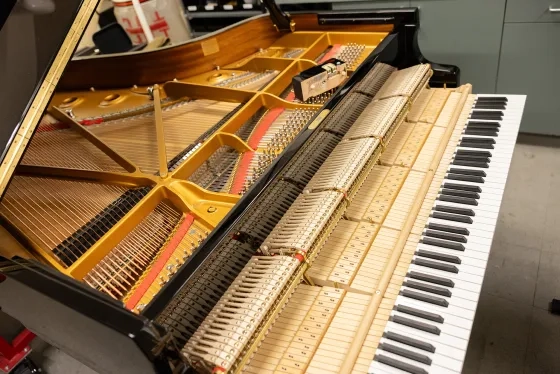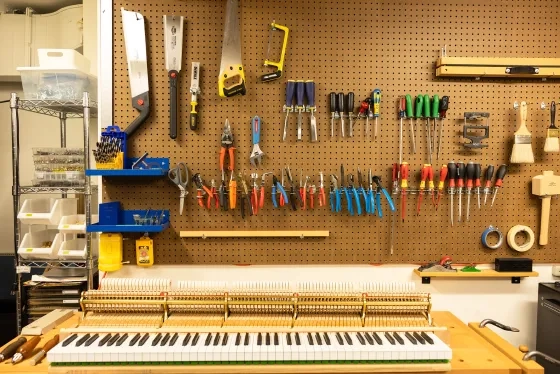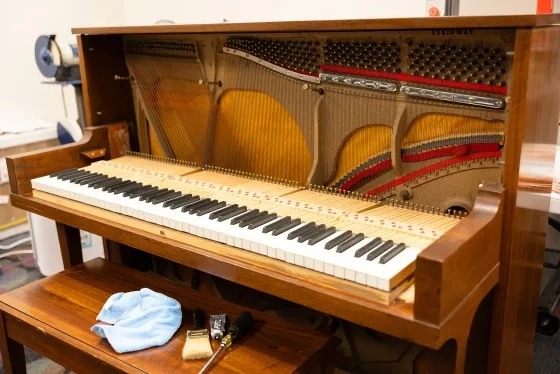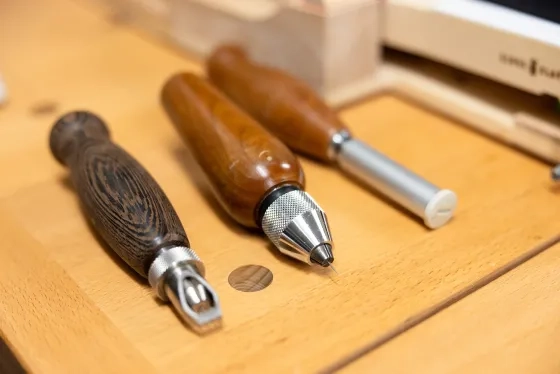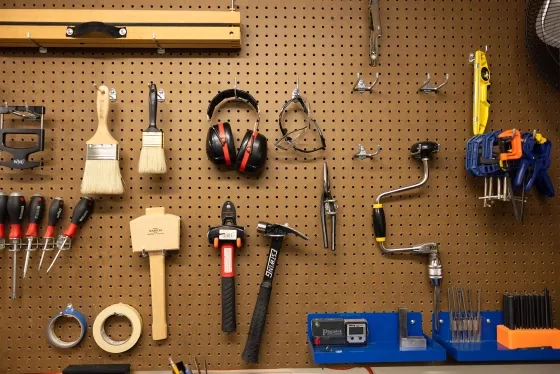How SFCM's Piano Technicians Keep 120 Pianos at the Top of Their Game
News StoryThe Conservatory has 120 pianos across two buildings, including a number of new Steinways: Here's a closer look at how they are kept in top shape for students, faculty, and visiting artists.
Ever wonder what goes into making a music school's fleet of pianos sing?
Of the 120 pianos at SFCM, there are 100 at the school's Ann Getty Center and 20 at its Bowes Center. Approximately half the school's grand pianos are Steinways—the most recent arriving in summer of 2022—while the others are Yamahas. And they're all overseen by the Conservatory's Director of Piano Services, Michael Disque, Piano Technician Brian Lee and technician Thomas Malone.
The two concert grand Steinways in each of SFCM's four performance halls receive the most attention from the piano maintenance team. "Before each semester, the concert instruments receive 10–20 hours of preparation, including voicing, regulation, and action part replacement—hammers, whippens—as needed," Disque explains. "During the school year, we tune and voice the concert pianos on a daily basis."
Disque calls SFCM's collection of pianos "incredible." "The majority of our Steinway grand pianos (approximately 80 percent) are either new, or were completely rebuilt, in the last five years. That statistic is remarkable, and it shows SFCM’s commitment to providing the highest quality pianos to students and faculty." (His personal favorites are a pair of Victorian-style Steinway Model As from 1905 and 1906 that were both completely restored and refinished in 2021.)
"Pianos at SFCM require regular tuning due to changes in temperature and humidity," Disque says. "We keep the tunings close to A441—the pitch standard at the school. In spaces where instruments receive heavy use, such as the piano major practice rooms and piano faculty studios, more frequent tuning is required."
The team's work is quite literally never-ending, a combination of constant assessments of the condition of pianos and planning for short- and long-term maintenance projects. "Routine maintenance—such as action regulation, pedal adjustments, damper recondition, action lubrication, and hammer filing—may be completed in the room where a piano is located," Disque says. "More extensive work is completed in our piano workshop, where we replace action parts, strings, key bushings, damper felts, key tops, key leads, and reconditioning pedal systems."
Issues faced by the team range from the more common broken strings or extraneous noises, to rarer issues like broken agraffes, loose pedal lyres, and broken legs. "Given that we have 120 pianos in use at the school, and there are over 12,000 parts in each piano, there are always unexpected situations that call for improvisation. We never know exactly how our workday is going to go," Disque says.
Non-pianists may not be familiar with one of the most critical aspects of the team's work: Voicing, or tone regulation. "When we have a piano with a new set of hammers, we voice the hammers to create a tone that is both ideal for the acoustics of that particular room, and suitable for how the piano will be used—e.g. solo piano, chamber music, or vocal accompaniment," Disque explains. "As the piano is played and the hammer felts become more compressed, the tone changes," he continues. "Fluctuations in humidity also have an effect on the sound of the instrument. Voicing thus requires near-constant fiddling, experimentation, and careful listening after each adjustment is made."
The complete "setup" of a new piano can take a week or longer. But generally speaking, a piano tuning takes around an hour, a figure that can increase if a pitch correction is needed or decrease if the midrange strings only require a touch-up. "The amount of tuning time required also depends on the level of perfection we are striving for in a particular situation," Disque says. "In the case of a concert piano tuning, the goal is maximum accuracy and stability, and that usually requires additional time."
One thing SFCM has going for its pianos, Disque says, is that, while the major structural components of a piano—the soundboard, bridges, and pinblock—may last for 30–50 years, or longer "In the Bay Area, temperature and humidity levels remain fairly constant throughout the year. Pianos in our region last longer than pianos in other areas of the country."
A common misconception about piano maintenance, Disque says, is that new pianos are easier for piano technicians to maintain than older pianos. In fact, he says, the opposite is true."For the first 1 to 2 years, new pianos are continually in need of tuning and regulation. New music wire takes time to stretch and settle to the point that the piano will reliably hold its tuning. Also, as a new piano is played, small pieces of felt throughout the action begin to wear and compress. Consequently, the 'touch' of a new, well-regulated action can change and go out of regulation in a matter of weeks. In the first year or two of a piano’s life, technicians diagnose and correct all of the quirky problems particular to that piano."
He also welcomes the opportunity to share the team's technical expertise about pianos with students and faculty. "An open dialogue between musicians and technicians often leads to insights on both sides of the conversation, and makes the work we do on pianos even more fulfilling."
Learn about studying Piano at SFCM.
